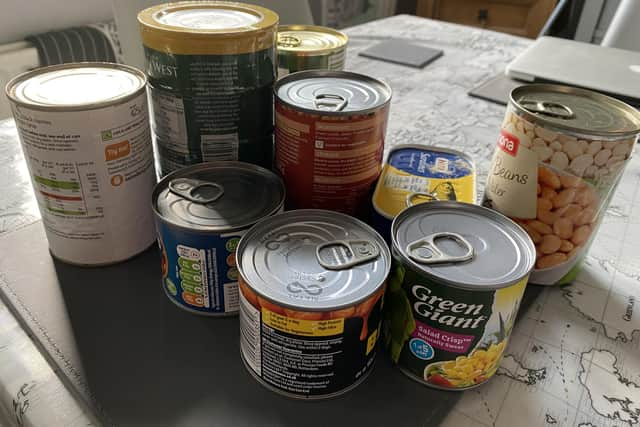Jonny McCambridge: A big question for our time: what’s the difference between a can and a tin?
and live on Freeview channel 276
As I sit with my son, struggling to keep his temper even as we plough through pages and pages of homework, another equally weighty conundrum presents itself. What’s the difference between a tin and a can?
The context is this. The homework involves us having to compile tallies to find out the greatest and least numbers of items within certain categories. One task is we have to go out outside to record the number of cars of different colours in our street (I particularly hate homework which involves me having to get up off the sofa). White turns out to be the most common.
Advertisement
Hide AdAdvertisement
Hide AdAnother section invites my boy to record the total of various food items in our kitchen. A central problem in this is that I haven’t been shopping so the fridge is barren. Unfortunately, there is no section which asks us to record the number of empty pizza boxes.


However, there is a space for the number of tins there are in the kitchen cupboard. Further down the page there is a separate box to list the number of cans. My son looks at me with a puzzled expression.
“Daddy, what’s the difference between a tin and a can?”
I smile indulgently and ruffle his hair. I am about to enlighten him when it occurs to me that I don’t have a ready response. My expression changes to one of great seriousness as I draw upon all my reserves of wisdom and experience to provide the answer. It is to no avail. “I’m sorry son, but I don’t think I know.”
This habit of being tripped up by my son’s homework is happening with an unwelcome and embarrassing frequency. An infant will assume their mum and dad knows everything. As they grow and their experience expands, they begin to realise parents are fallible and their knowledge has its limits. I fear my son is on the point of realising his daddy is a great big bluffer.
Advertisement
Hide AdAdvertisement
Hide AdLast week we were working through a series of maths problems. We came to the following question. Six apples and two oranges cost 70p. An apple and an orange cost 19p. How much is one orange? My son stared at me. I stared back at him. Then I looked out the window. I looked back at the maths problem.
“Six apples and two oranges for 70p? That must be the cheapest shop in the country.”
My son smiled weakly at my bad joke, although, in fairness, he had heard it on countless other occasions when I’ve been stuck at maths homework. I knew that I could probably work out the sum by randomly attaching values to the fruit until I chanced upon the answer. Essentially, guessing until I got it right.
What bothered me was that I knew there had to be a method, a shortcut for working this out, and I had no idea what it was. There was no wisdom to be passed on to my son. Something told me that a working knowledge of algebra might be a useful tool. However, it was a tool I did not possess. We got the answer in the end, but it took a long time.
Advertisement
Hide AdAdvertisement
Hide AdWhich brings me back to the can and the tin. My son and I had a quick brainstorming session on what the differences might be. The material the container is made from? The shape? The nature of the foodstuff kept within? It seemed to us that you were more likely to use the name tin for beans, but can for Coke. But why?
Being able to summon no more illumination, I turned to an old familiar friend which has helped me multiple times with homework queries. Google. I opened my phone and typed in "What is the difference between a tin and a can?”
Reassuringly, it seemed I was not the first person to encounter this difficulty as there seemed to be a wealth of online conversation on the subject. The first link I clicked on said, “Tin is a metal. Can is an object which is often made from tin. While a wall made of cans and a wall made of tin could be the same wall, it is only because cans can be made of tin.” I thought this was a semi-useful beginning.
The next explanation read was: “A can is cylindrical. A tin is usually rectangular; lower than it is wide (rather flat), and almost exclusively used for containing preserved fish, eg a tin of sardines or a tin of kippered herring.” Really?
Advertisement
Hide AdAdvertisement
Hide AdMy brow furrowed as I read further definitions. Some people suggested that tin was a British word originating from the material the container is made from, while can is a US word for a sealed metal container with all the air removed. More suggested that tin should be used for food and can for drink, while some said that the correct expression was ‘tin can’.
Then somebody else pointed out that most tin cans today are made of aluminium. Soon I found myself reading articles on the relative merits of using aluminium cans and tin cans. Within 15 minutes I was reading a trade article on the merits of using zinc as an alloying agent in making steel.
Eventually my son brought me back to focus.
"Daddy, have you found out the difference between a tin and a can yet?”
I looked at my boy and noted his expectant expression. I hesitated. “I think we’ve opened a can of worms here son...or should I say a tin?”
He didn’t laugh. I returned to the homework sheet. The empty white boxes asking us to record the number of tins and cans in my kitchen. “Just write down 17 and 22,” I said.